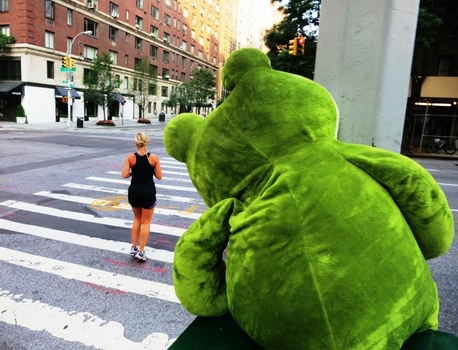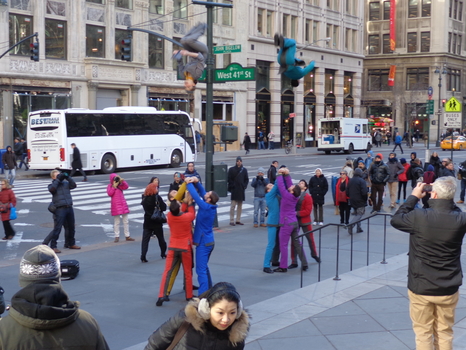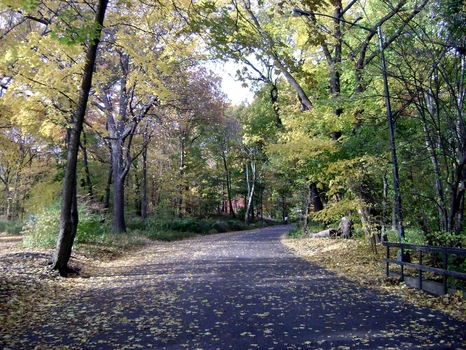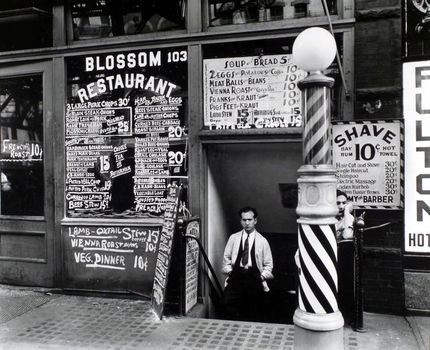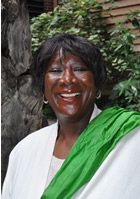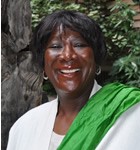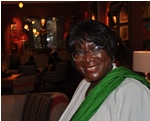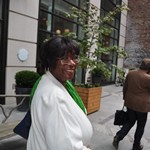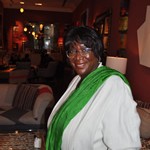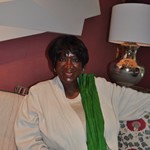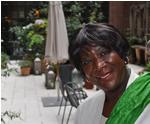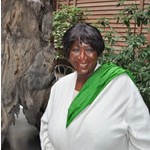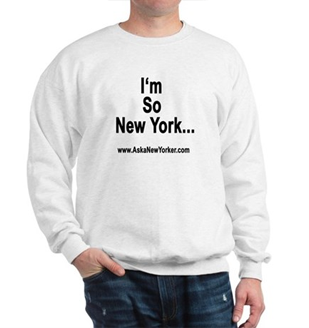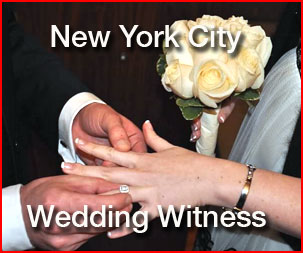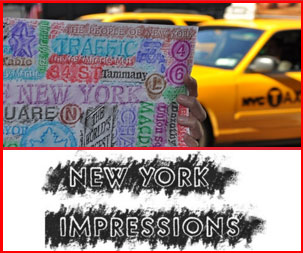Ask a New Yorker: Pearl Duncan – historian, author, poet, adventurer, public
speaker, genealogist, yacht racing writer…
Pearl: Yacht racing writer.
Ask a New Yorker: But can you dance?
Pearl: I can dance. I use to do go -go dancing, when I was in school. I know
I shouldn’t be telling these stories, but I was at an Ivy League school,
Bryn Mawr. I thought “I don’t like to waitress; I’m not good
at it”, so I had to find something to do other than waitressing, because
that was how scholarship students and other students earned extra money. So
another student and I started dancing, and then we started getting invitations
to all the other schools, Yale, Princeton etc. to dance. So at the Princeton
junior prom we were the dancers when Smoky Robinson performed, and so on. It
was great fun.
Ask a New Yorker: Pearl Duncan, what a lovely name. Who are you?
Pearl: I am from people who are so attached to names and naming, if you know
anyone who has Caribbean heritage, even if they were born in New York, they’re
named after a flower or gem. My maternal grandmother, Rebecca, did the naming
in our family so all of us were named by one person. When I first realized this,
I thought wow, the mothers really doesn’t have the power, the elders who
did the naming did. They have the tradition of recycling the names, so the whole
tradition of naming carried on. There are only two people in my family who did
the naming, my paternal great- grandmother, Elizabeth, nicknamed, Mmeme, and
my maternal grandmother. My other paternal great-grandmother was nicknamed,
Nunus. Our family’s nicknames, including mine, were passed down from our
medieval African and colonial American ancestors.
Ask a New Yorker: Pearl Duncan the 1st?
Pearl: I am the first-born so my grandmother simply took the gem and flower
of her birth month and gave it to her first born granddaughter. It’s a
whole tradition of the sweetness of passing on the newness and the beauty of
the universe in the names. I am American, but when I researched our African
nicknames, I saw that they used the same tradition. Most of my ancestors and
my DNA connect to Ghana. In Ghana there’s something called the name tree.
The family has an ancestral name tree and they gather together and decide which
name that child should get. Often the father in the paternal cultures gets to
select the child’s name. But in other cultures the women, usually the
grandmother, will select the child’s name.
Ask a New Yorker: But who are you?
Pearl: I am a person who has a lot of high adventure energy. I attract people
who have high adventure energy. Then they discover I am a very reserved and
laid back, a very calm person. It’s been absolutely fascinating, even
in terms of what I write. I was just reading the reviews of two books about
style and pronouns, The Secret Life of Pronouns and Microstyle . Often when
I posted articles I went online and discussed with readers who were commenting.
European readers always say I’m a male writer. “My name is Pearl,
don’t they realize Pearl is a girl’s name?” And I now realize
from reading the reviews of these books that when I’m writing about history,
according to these writers, I use a lot of “male” pronouns. I didn’t
know that before. But that comes from the idea that I’m a person who likes
to be exact. So I research the primary sources and if I’m retelling something
as it happens I tell it very forcefully. I bought both books.
Ask a New Yorker: Where did you grow up?
Pearl: I went to school in Manhattan. I grew up in The Bronx. We had a townhouse.
We lived on two floors and rented out one. And then we moved to what my Dad
thought would be a proper house. A proper house should have a front door and
back door. So he bought a house that has one of the largest gardens in The Bronx.
It has a back yard, side yard and a front yard. He grew every vegetable possible.
He would go to church. He was a minister. He attended to his church business
and he was also a realtor. We had one rule for him, and that was he could not
plant vegetables in the front yard. The front yard was for flowers. But he was
a natural born farmer. We are descendants of farmers in ancient Ghana.
Ask a New Yorker: I mentioned yacht racing – you clarified yacht racing writer.
Pearl: Well, growing up in New York you’re very focused on being a “New
York” person. And even my mother would say I’m a New York lady now,
I’m not that Jamaican lady. So one of things I started doing even in school
was traveling to discover more about who I am and people I’m from. All
the money I earned, I used to travel. When I was in school, I literally did
a lot of one way traveling where I went somewhere and had only enough money
to get back. As a result, after college, I started writing about the places
I was visiting. So other people went on Spring vacation to party. I went and
absorbed the culture and the people and talked with them and interviewed them.
I came back with so much information. As soon as I was able to start publishing,
I started doing travel articles. I wrote about all the continents except Asia.
I thought OK, this is getting repetitious and I need to find an activity that
connects to travel. I eliminated things like bull fighting. I thought, “Oh
no, I don’t want to do that again”. I was in Sardinia and I saw
a yacht race. The people were so fascinating because these were international
business types, the king of Spain, the Aga Khan, but on the water they were
just sailors. I thought OK, there is so to learn from interviewing these high
adventure people. So I came back to New York and enrolled in a Coast Guard course,
how to sail safely, down in Battery Park. They took us up to City Island. What
they were teaching us was just how to survive in the water. So we went out in
a dingy and capsized. They just kept capsizing us, so we learned how to survive.
It wasn’t just a classroom course, it was an ocean survival course. So
now I thought OK, I’m ready to write about yacht racing. I can’t
race. I can’t even sail well. But I can describe what I saw the yacht
racers doing, and I did it so well that often the skippers said, ‘Can
you come and crew with us? I loved your last article”, and I would have
to tell them, ”I can write about racing but I cannot race”. So the
whole idea was following a passion. I went out and did what they were doing.
Their only prize was a trophy. Mine was the adventurous ocean experience.
Ask a New Yorker: Which races did you cover?
Peal: I did all Caribbean Ocean Racing Circuit. I’ve seen 31 Caribbean
islands. And I did some of the European races. I did the race in Australia.
Ask a New Yorker: Did you ever get seasick?
Pearl: I wore a patch nonstop. It was part of my wardrobe. I only wore red and
white. I wore white bathing suits and dresses.
Ask a New Yorker: Where should we sail from here?
Pearl: Well, since I stumbled onto sailing accidently it became such a passionate
pursuit that it is a main part of my research. I had interviewed lots of sailors,
including some at the New York Yacht Club. I’ve researched New York’s
waterfront. Most of my New York articles in my blog deal with the waterfront.
So when the ship was discovered at the Trade Center, I thought “that’s
my story”. I have read all the primary documents about ships and New York’s
colonial sailors.
Ask a New Yorker: They found a ship inside the World trade Center?
Pearl: When they were digging the foundations for the new World Trade Center
at Cedar Street they discovered the hull of an 18th century merchant cargo ship,
but they only found half of the hull. What they realized was the sluice wall
that is designed to prevent the water from flooding the construction site had
cut the ship in half. So last summer in 2010 they discovered half of the ship
and this summer, 2011, they discovered the other half. And the rush was to preserve
the ship’s timber. The Port Authority of New York and New Jersey, which
owns the site and all the artifacts, gave them three days to remove the hull
of this 18th century ship. http://www.pearlduncan.com/books/WTCShip.htm
Ask a New Yorker: That’s an archeologist’s nightmare.
Pearl: They worked as fast as they could and now they are preserving and documenting
the artifacts that were found on the ship. They hired marine archeologists and
some historians. But the historians basically said they and most historians
know the military ships, because those ships have been so well documented, because
they don’ know the colonial merchant cargo ships. What I was hearing is
we tell the history in terms of wars even in New York. But very few, even the
marine historians, know the merchant cargo ships. And I thought, I know every
merchant cargo ship that passed through New York, because when I researched
ancestors, that’s all I researched, the colonial ships. Hundreds and hundreds
of and thousands of merchant cargo ships for three centuries, and having two
ancestors that were here in New York, I did a lot of research in the historical
and municipal archives here. I have one Scottish merchant ancestor who died
in New York in 1801. And I have an ancestor who was a colonial New York governor
from 1710 to 1720. I researched them so I know all about lower Manhattan.
Ask a New Yorker: How far back can you trace your family tree?
Pearl: My family tree in terms of the written documents goes back to the 1690’s.
In 1726 one of the ladies from Ghana had a child with a Scottish merchant who
happened to have been a noble, related to the Kings of Scotland and England.
So when I contacted Scotland and said I had these documents they said, “Well
you qualify for a coat of arms”, so I have a Scottish Coat of Arms. In
my research, I read slave trader’s journals from medieval Africa and colonial
America and collected our ancestors’ birth documents and their stories.
Ask a New Yorker: I bet you’re reading all types of interesting books.
Pearl: The book I am reading is in fact 1493 by Charles Mann. I had read his
1491 and Steve Pincus’ 1488. I like reading nonfiction where the writers dig
down, deeply into details of the past. I recently finished reading Isabel Wilkerson’s
The Warmth of Other Suns: The Epic Story of America’s Great Migration.
I like reading epic and mythic-length nonfiction. It’s like entering a
world of fabulous ideas.
I enjoyed reading Jared Diamond’s Guns, Germs, and Steel: The Fates of Human
Societies, Jacque Barzun’s From Dawn to Decadence: 1500 to the Present: 500
Years of Western Cultural Life, and all of Thomas Cahill’s books, The Gift of
the Jews: How a Tribe of Desert Nomads Changed the Way Everyone Thinks and Feels,
How the Irish Saved Civilization, and the others. And even Arthur Herman’s How
the Scot’s Invented the Modern World, and of course I’ve read all the DNA and
human ancestry books, geneticist Bryan Sykes’ Seven Daughters of Eve Matt Ridley’s
Genome: The Auto biography of a Species in 23 Chapters, Cavalli-Sforza’s The
History and Geography of Human Genes, and some others. And as I mentioned, other
than Howard Zinn, I don’t see other writers who are turning a microscope on
a particular era in America history in the world. I like reading nonfiction
history that digs deep into how people lived and thought. But I also love reading
about relationships and European writers who write these mega histories. For
some reason we talk about the great American novel but we don’t really
tackle the The Great American non-fiction. I read Isabel Wilkerson’s book
about African American migration. That was an attempt to do a mega nonfiction
narrative. I don’t understand why these European writers can do these
broad historical books and more American writers don’t. Maybe it’s
a question of editing. There are so many books that have the title about people
who changed the world, but very few books about how Americans changed the world.
I read lots and lots of books about African-American history and culture. I
think we need to do a better job of embracing all our histories and cultures.
I’m now reading Exploring Historic Dutch New York.
Ask a New Yorker: One of my favorite books is” Here is New York”
by E.B.White.
Pearl: I did my freshman thesis on that book and other E.B. White essays, because
I was very influenced by non-fiction literature at school. This is the school
that said if something was less than one hundred years old it hadn’t stood
the test of time. I thought, “Oh my God how will I survive with that concept
of literature?” So I did by freshman thesis on E.B White.
Ask a New Yorker: Occupy Wall Street protestors are trying to change the world.
Pearl: I knew the protest would catch on nationally. I see New York, America,
from an historical stream. In terms of the protest and how much they’re
sacrificing just to get their message out, I was not surprised when the police
used a very unknown, very rare colonial law, the one about wearing masks to
make the first arrests. The first group of protestors who were arrested were
arrested based on an 1845 law. The law said it is illegal in New York state
to wear a mask. That started when the farmers upstate who used to bring their
produce down to Lower Manhattan, protested prices and inequalities. They were
tenant farmers and they protested against one of the major property owners.
They were protesting quite violently so they were attacking the supervisors
of the farm and police. So they covered their faces. The legislators wrote a
law that said it is illegal in New York to cover your face during a protest.
This law is still on the books and somehow somebody in the police department
or in the legal department knew it and used it. I thought,”OK, it is not
a good idea to ignore what happened in the Colonies because it can come back
and bite you.”
Ask a New Yorker: What would you like to see changed in New York?
Pearl: I think we take gentrification in stride. Actually I don’t think
we should. I hate seeing neighborhoods change so drastically. I’m in a
neighborhood that gentrified from the small merchants who were in the markets
that were downtown to Tribeca, and then the artists from the art district. Right
now, you and I are sitting in Soho, the art district, I’m sure there are
very few artists who are still surviving in Soho. That’s one thing about
New York I wish would slow down a bit. We are just too accepting of gentrification.
We should allow communities and the people who settle them to last a little
bit longer.
Ask a New Yorker: What do you think of the concept Ask a New Yorker?
Pearl: Ask a New Yorker? I like the concept because I think each New Yorker
experiences the city so differently. I like to experience the city on the subway.
I look at the faces and I connect them to different parts of the world. I like
to place faces on a map of the world. Recently, it’s been hard, like a
number of Mexican Americans it’s hard to tell them from the Middle Easterners
or Philippinos and so on. But then when you look at what everyone is bringing
to the city or what it is they expect from the city, there’s a commonality
there. I don’t even see the diversity. I see the commonality. You know
in the sense that there is this common feeling, a common feeling that whatever
we want to do can happen here in New York. I guess it is like the song “New
York. New York, says, “That if it’s going to happen anywhere it’s
going to happen in New York”
Ask a New Yorker: Any last thoughts?
Pearl: I am finishing a book about the 18th century merchant cargo ship which
is a totally different lost story about New York as a major international seaport.
You talk about confluence or lay lines and how things come together. When I
toured the 9-11 Memorial and saw the oak and acorns falling, I picked up the
acorns because the 18th century ship that was discovered right underneath where
the Memorial is, on Cedar Street, was made of white oak. The ship was made of
oak. White oak is becoming a symbol of New York, past and present. And hopefully
future. Oaks and acorns are positive; they represent strength and growth. My
Grandma Beckie used to sing a song about the mighty oak.
Ask a New Yorker: I look forward to reading the book! Thank you Pearl it was
a pleasure meeting you.


